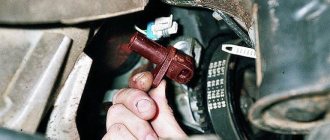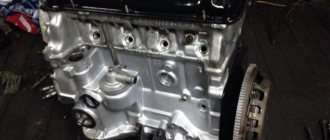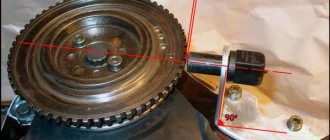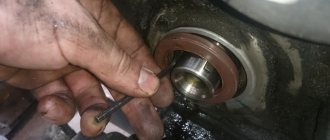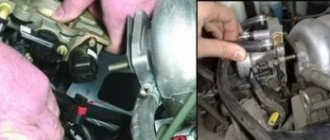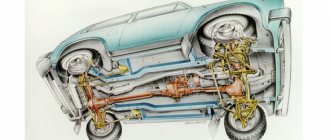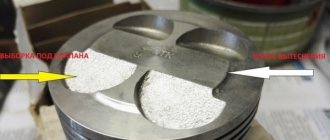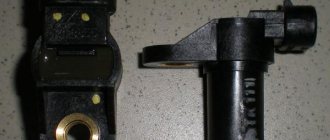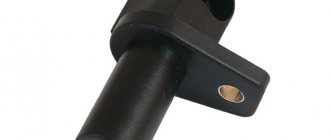Engine VAZ 21213-1000260. Characteristics of the VAZ 21213 engine.
The engine is four-stroke, carburetor, in-line, with an overhead camshaft. The engine cooling system is liquid, closed type, with forced circulation of liquid. The engine has a combined lubrication system: pressure and splash.
| Number of cylinders: | 4 |
| Cylinder displacement, l: | 1,69 |
| Compression ratio: | 9,3 |
| Rated power at a crankshaft speed of 5200 rpm: | 58 kW.-(78.9 hp) |
| Cylinder diameter, mm: | 82 |
| Piston stroke, mm: | 80 |
| Number of valves: | 8 |
| Minimum crankshaft speed, rpm: | 750-800 |
| Maximum torque at 3400 rpm, N*m: | 127 |
| Cylinder operating order: | 1-3-4-2 |
| Octane number of gasoline: | 91-93 |
| Fuel supply system: | carburetor |
| Spark plug: | A17DVR, BP6ES(NGK) |
| Weight, kg: | 117 |
Engine Features.
The VAZ 21213 engine can be used for installation on VAZ Niva cars: 2121, 21213, 21214, 2131; "Nadezhda" 2120 and their modifications.
This internal combustion engine was developed specifically for the Niva VAZ-21213 car. Based on the center-to-center distance of the cylinders of 95 mm, it can be classified as a group of internal combustion engines installed on rear-wheel drive cars. They were located in the engine compartment along the axis of the car.
Engine cylinder block 21213-1002011 with a center-to-center distance of 95 mm and a height of 214.58-0.1 mm (distance from the axis of rotation of the crankshaft to the upper surface of the block). The nominal diameter of the cylinders is 82mm. TBO dimensions - 82.40 and 82.80. Five classes are defined based on the deviation of the cylinder diameter. The size of each class differs from the previous one by 0.01mm. Classes are designated by letters (A, B, C, D). The cylinder block is marked on the lower surface of the block (see “Cylinder block”).
The engine is equipped with a crankshaft 21213-1005015. According to its parameters, it corresponds to the crankshaft 2103 and provides a piston stroke of 80 mm. (crank radius – 40mm.). The shaft has additional counterweights that reduce vibration. There are two oil supply holes on each crankpin. The diameters of the shaft journals are increased by 0.02 mm. When using standard bearings, this reduction in clearances optimizes the thickness of the oil layer between the shaft journal and the bearing surface. At the same time, reducing clearances improves the dynamic characteristics of the shaft. Crankshaft 21213 is recommended for installation instead of shaft 2103.
A new piston group has been developed for the engine. Piston 21213 is of original design; it has a specific oval hole on the bottom. For piston diameters, classes corresponding to cylinder classes are defined. The hole for the piston pin is 22mm in diameter. In the piston, the hole for the piston pin is offset by 1.2 mm from the piston axis. The piston class marking by diameter and pin hole size is indicated on the piston bottom. The piston pin, 67 mm long, is fixed in the piston with retaining rings. The weight of the piston is 347g. During manufacturing, all pistons are brought to the same weight.
Connecting rod 21213-1004045 has a new design. The length of the connecting rod is 136 mm. Hole sizes: for the connecting rod journal - 47.8 mm; piston pin – 22mm. New bolts were used to fasten the connecting rod cover, ensuring reliability and accuracy of assembly.
VAZ 21214 engine modifications and their differences
| Motor modification | Availability of power steering | An exhaust manifold | EURO environmental class |
| 21214-41 | welded from stainless steel become | 3 | |
| 21214-34 | _ | cast iron | |
| 21214-33 | |||
| 21214-32* | |||
| 21214-31 | welded from stainless steel become | 4 | |
| 21214-30 | — |
*21214-32 – has fuel pipes with quick connectors, a flywheel for the clutch of 215 mm (200 mm on other models).
The geometry of the cylinder block 21214 and 21213 is the same. There are no liners in the cylinders. Due to the use of an ejector, the configuration of the front engine cover has been changed to accommodate the installation of a crankshaft position sensor. To mount the power steering, a hole is made on the block for installing a bracket; in addition, there is a threaded hole for installing a knock sensor, as well as threaded holes with studs for mounting the ignition module bracket.
The ShPG came from 21213. Crankshaft 21213-1005015 sets the piston stroke to 80mm. The crankshaft pulley is distinguished by the presence of teeth along the outer diameter for the operation of the crankshaft position sensor. The latest internal combustion engine models are equipped with a damping pulley (21214-1005058-10). The presence of a damper made it possible to reduce the load on the crankshaft to prevent cutting of the key, and also make the operation less noisy.
Cylinder head 21214-1003011-30 (36) was modified from the head from 21213. For modification, it was necessary to introduce holes for installing a phase sensor and studs for mounting the intake receiver. To install hydraulic compensators, bosses are cast in the head and have threaded holes in them. With the introduction of hydraulic thermal gap compensators, adjusting bolts were eliminated from the head design.
Oil under pressure is supplied to the hydraulic compensators through separate pipes. There are two types of heads: Russian 21214-1003015 and Canadian 21214-1003015-30. The differences between the heads are as follows: in the first, the diameter of the threads in the holes for hydraulic compensators is M18/1.5, the wells for hydraulic compensators do not have drainage holes;
the second ones have M24x1.5 holes, and the wells have drainage holes (the markings are made in the casting). Interchangeability of heads, as well as hydraulic supports of old and new designs, is not possible. A new oil rail 21214-1007180-30 made of stainless steel is used, supplying oil to the hydraulic compensators. Interchangeability with ramp 21214-1007180 is maintained.
Valve levers 21214-1007116-30, in contrast to the previous 2101-1007116, have a smaller radius (11 mm) of the platform support interacting with the camshaft cam, as well as an additional groove on the side of the hydraulic compensator. Both lever options are interchangeable.
Also interesting: Lada Niva 2021 new body | Lada Niva Chevrolet prices and equipment 2021 from an official dealer.
In the timing camshaft drive, instead of a double-row chain, a single-row chain 21214-1006040-03 is used on rollers and bushings. Single-row sprockets for the chain are taken from the 2123 engine. The oil pump sprocket has the number of teeth reduced to 30 to increase the performance of the oil pump and improve the operation of the hydraulic chain tensioner and hydraulic compensators.
The camshaft 21214-1006010 is original with a modified cam profile and can be interchanged with the shaft from 21213.
The 80 amp generator is the same as the 2112, with a slight difference in the diameter of the pulley 80 mm for the drive belt 2107-1308020 (944 mm).
The exhaust manifold can be made of cast iron or stainless steel. The cast iron manifold is made by casting. The stainless steel manifold version has a welded design. A welded manifold is lighter and heats up quickly, which is good for the operation of the catalyst located in the manifold. In addition, an oxygen sensor is installed in the exhaust manifold.
The intake manifold and fuel rail (2123-1144010-11) were borrowed from the 2123 engine. The injectors of the fuel injection system are SIEMENS VAZ 20734 (yellow), injectors (0280 158 110) were installed on early engines.
Ignition module from engine 2112.
Electronic control is carried out by the BOSCH MP 7.9.7 ECU. or JANUARY 7.2 depending on the year of manufacture and modification of the internal combustion engine.
The cooling system began to be assembled using gaskets with an elastic polymer bead, which improved the tightness of the system. The water pump (pump) includes an oil seal (cuff) that is more resistant to wear and loss of properties.
General information
When creating the Niva car, the designers were faced with the lack of a motor of suitable power. The existing engines with a volume of 1.2-1.5 liters were not very suitable for a car with all-wheel drive. The situation was saved by the appearance of a larger engine, model 2106. By maximizing the cylinder diameter, its displacement was increased to almost 1.6 liters, and its power reached 80 horsepower. It was this engine that became the main power unit of the Niva for more than 20 years.
In the mid-90s, the Niva underwent modernization, during which a number of changes were made to its design. The design of the rear of the car has changed, as well as many elements of the SUV's interior. The 1.7-liter VAZ-21213 engine began to be used as the base power unit. Initially, the engine was developed for the modernized car of the seventh model, but the SUV project turned out to be more promising.
Peculiarities
If the manufacturer does not provide the opportunity to buy a Lada 4×4 with a diesel engine, then craftsmen will appear who will install it with their own hands. So, which diesel engine is suitable for the VAZ 2121? Here are the most popular models:
- Peugeot XUD-9SD (1.9 l, about 70 hp) together with Fiat Polonez gearbox.
- Peugeot XUD 11 with Fiat Polonez gearbox.
- Toyota 3C (79 hp) or 3ST (100 hp) together with Toyota Noah gearbox.
- Motor from Volkswagen Vento.
- And many others.
To install a diesel engine, a large number of modifications will be required. The simplest and most common way of such tuning is to use the engine that was installed for export versions of the SUV (XUD-9SD). Its installation requires the least amount of changes to the machine design. It has a good location of the oil intake (in the front, not in the center or rear), the oil filter (on the front left, like the Lada 4x4) and attachment points to the body. In addition, it is easy to find spare parts for this engine model. The approximate procedure is as follows:
- Engine mounts are suitable for VAZ 21215.
- The gearbox bell and the box itself fit well from Fiat Polonez.
- Rework the pan, oil intake, flywheel, exhaust system, etc.
- The easiest way is to complete all the modifications according to the documents.
In other words, no diesel engine can be installed instead of a gasoline engine without modifications. What do you think, is it necessary to change the Lada 4×4 internal combustion engine to a diesel one? If yes, which one and why? Let us remind you that you can improve off-road performance in an easier way, for example, by installing mud tires.
Keywords: 4x4 engine | 4x4 gearbox
Found an error? Select it and press Ctrl Enter..
- Brigade 341 PrP became the best in quality of work
- How to remove the radiator grille of a Lada Granta (two methods)
- Video review of how the standard Lada Vesta audio system works
- AvtoVAZ instructions for eliminating the squeaking of the Lada Granta parking brake cable
The VAZ 21213 four-cylinder eight-valve petrol engine has a displacement of 1.7 liters. The power of the power unit is 81 horsepower with a torque of 125 Nm.
Engines 21213 in their latest generation were equipped with an injector and ran on high-octane 93 gasoline. The cast iron cylinder block ensured maximum strength for this power unit.
The use of numerous automatic engine control systems made it possible not only to change the traction performance of this engine, but also significantly improved fuel efficiency. Niva in suburban mode consumes 8.3 liters of gasoline per 100 kilometers when driving at cruising speed.
Also interesting: Replacing the pan gasket for VAZ 21214
Starting from 2014, Niva cars with a diesel engine are also offered to customers.
The Niva engine with an overhead camshaft is equipped with a chain drive, which significantly simplifies the service of this power unit. The chain drive does not require replacement of the tensioner or any adjustment during operation of the motor. We also note the presence of hydraulic compensators, which relieves the car owner of the need to carry out the procedure for adjusting the valve clearance. All maintenance work on this engine can be performed by the car owner himself, without contacting branded service stations.
Main differences
The motor uses a block from the sixth model engine as a base. But it has new pistons that have an original design. Because of this, it was necessary to introduce some solutions to the layout of the cylinder head and engine connecting rods. Early versions of the engine were equipped with a Solex carburetor (model 21073), which helped reduce fuel consumption and reduce the amount of harmful components in the exhaust gases.
At the time the updated Niva entered the market, a similar fuel supply system provided quite acceptable technical characteristics of the VAZ-21213 engine. The engine power increased slightly - to only 79 forces, but much more important was the resulting increase in torque, which amounted to almost 125 N/m. Thanks to this, the Niva has become noticeably better at negotiating difficult sections of roads. At the same time, the engine used the most common type of gasoline - A92 - as fuel.
Motor shafts
The main shaft of the motor is borrowed from the power unit of the third model (with a volume of 1.5 liters). It has cranks with a rotation radius of 40 mm, which provides 80 mm of stroke for the engine pistons. To reduce vibrations and ensure more uniform operation, there are additional counterweights on the shaft. They are located on all shaft cheeks and are made in one piece with the shaft. One of the differences in the VAZ-21213 engine shaft was a slight increase in the diameters of all shaft journals (by only 0.02 mm). This decision was dictated by the desire to reduce the oil gap when the engine is running. Reducing the clearance reduces the force required to rotate and slightly improves the overall performance of the motor.
There is a special channel inside the shaft through which oil is supplied under pressure to the loaded structural elements. When the shaft rotates, the oil undergoes additional cleaning in the channels from large impurities due to centrifugal force. Dirt is deposited in special holes closed with screw plugs. These holes are cleaned during engine repair.
At the toe of the shaft there is a gear drive for the distribution system and a pulley that serves to drive the pump and generator belt. Between the gears of the main and camshafts there is a double design chain consisting of 116 links. To tension the chain, there is a special device with an increased length of the working element (shoe), which bends one of the side branches and selects the excess length. The engine lubrication system pump is driven from the same circuit. The distribution shaft has cams with a modified profile, which made it possible to increase the opening time of the intake valves.
Weaknesses of the VAZ 21213 power unit
- Water pump;
- Engine, manual transmission and transfer case oil seals;
- Generator;
- Starter;
- manual transmission;
- Valve cover gasket;
- Cooling system pipe connections;
- Radiator;
- Thermostat;
- Expansion tank;
- Vacuum brake booster.
The water pump (pump) is characterized by frequent failures on new cars after 2,000 km.
Due to poor quality, oil seals require more frequent replacement than required according to the operating manual.
The generator has a high probability of failure. As a rule, it burns out even on new cars that have not reached 4,000-10,000 km.
The starter has a low service life without repair.
On a gearbox, one of the common defects is the fifth gear slipping out. In addition, the gears are not fully engaged.
The valve cover gasket loses its properties over time and allows oil to leak out.
The connections of the cooling system pipes in the places where the clamps are installed are not reliable and lose their tightness very early, which is fraught with loss of antifreeze.
The radiator is leaking. The problem occurs due to the appearance of cracks in the radiator pipe package, accompanied by loss of coolant. This defect has become widespread.
The thermostat does not provide thermal conditions for the coolant in the engine cooling system. The manifestation of this problem is no exception. The cause of the defect is a failure of the valve mechanism inside the thermostat. To check that the thermostat is working properly, after starting the engine, simply place your palm on the lower (outlet) hose, through which hot antifreeze circulates into the radiator for cooling. If the thermostat is working properly, after some time the hose should become hot; if the hose remains cold, the thermostat must be replaced.
The expansion tank cracks and antifreeze leaks out. The appearance of cracks occurs due to the failure of the steam-air valve in the tank plug due to increased pressure.
Vacuum brake booster (VUT). Manifested by a stiff brake pedal. The speed may fluctuate when the brake pedal is pressed, as well as hissing. The problem is solved by replacing failed rubber products and replacing clamps in connections.
Also interesting: Tuning Niva for off-road use - Lada master
Cylinder block. This weak point appears on various models of Nivov engines, including the previously discussed 21213. Due to insufficient quality control, the assembly unit is manufactured with a high percentage of factory defects. In short, the drilling depth of the intake manifold stud holes is not maintained, causing the holes to meet the camshaft stud holes.
In this way, L-shaped through channels are obtained. After installing the studs at the factory, the connections remain sealed for some time and the problem is not identified when the quality control department employees accept engine tests. After the sale of new cars with low mileage, during sharp braking, oil begins to seep through the studs onto the hot intake manifold, so much so that smoke from the oil burning in the manifold pours out from under the hood, and accordingly, there is nothing to breathe in the cabin.
A sketch for the technical specifications for eliminating oil leaks from under the exhaust manifold studs.
- Remove the GC cover;
- Unscrew the two studs securing the bearing housing (see sketch) and remove oil from the threaded holes;
- Thoroughly degrease the holes and stud;
- Apply sealant UG-10 or its analogues to the lower threads of the studs;
- Place the studs in place;
- Tighten the bearing housing nuts;
- Install the cylinder head cover;
- Wait at least 30 minutes for the sealant to set.
Piston group
These VAZ-21213 engine parts are made of aluminum and are not borrowed. At the bottom of the pistons there is a special recess that serves as part of the combustion chamber, as well as two annular recesses for the valve plates. The tightness of the piston-cylinder pair is ensured by three rings. On the bottom of each piston, a part class is indicated, which reflects the diameter of the piston and the diameter of the hole for installing the pin. Another important difference between the pistons is the same weight, which greatly simplifies the procedure for selecting new parts.
The connecting rods of the 21213 engine have a special design, which increases the strength and service life of the part. The caps of the connecting rod bearing inserts are secured with bolts of a special design, which prevents the tightening from decreasing during operation.
Malfunctions
| FAULTS | CAUSES AND REPAIRS |
| The appearance of a characteristic knock at the bottom of the engine. | This indicates problems with the main bearings. The car must be towed by a tow truck to a service center and the appropriate repairs must be carried out. |
| The appearance of a pronounced knocking sound with a metallic sound. | The reason for this is problems with the bearing rods and piston pins. It should be said that operating a car with such problems may subsequently lead to the need for expensive major repairs. |
| Engine troubles at low speeds. | There may be several reasons for engine tripping: first of all, it is the use of low-quality gasoline. It is also possible that carbon deposits may appear in the combustion chamber. In rare cases, problems are observed in the operation of the injection system. Repair in this case is carried out only after a comprehensive diagnosis. |
| Loud knocking sound when the engine is not warmed up. | This may indicate the beginning of camshaft wear. This problem is typical for power units whose mileage exceeds 100,000 kilometers. It is necessary to carry out appropriate diagnostics and then replace the camshaft. |
Also interesting: Interchangeability of the Zhiguli and NIVA gearboxes (is it possible to install a Zhiguli gearbox on a Niva)
Motor development
Since the carburetor of the VAZ-21213 engine did not allow further improvement of the environmental characteristics of the engine, it was replaced by an injection system. This power unit received the designation 21214 and a slight increase in power and torque. Another direction of development was version 2130, which is installed on the Chevrolet Niva. Today, all three variants of engines with injector remain in the series - 21213, 21214 and 2130.
During the modernization of the Niva, the designers took a number of steps that were designed to increase the car’s attractiveness to buyers, especially given the increased competition from imported equipment. On the other hand, it was necessary to maintain the pricing policy, unpretentiousness and cross-country ability at an acceptable level - these are precisely the components that determined the success of this car.
One of the requirements for the new Niva was to improve dynamic characteristics and increase efficiency. Therefore, for a car based on an old carburetor in-line engine, a VAZ 21213 engine was developed whose technical characteristics were an order of magnitude better. The main change was an increase in engine displacement - this made it possible to increase engine power and torque, while the engine became more reliable. The use of a new carburetor made it possible to reduce fuel consumption to almost European levels.
Characteristics of the VAZ-21213 engine
| Type | Inline four-cylinder petrol |
| Working volume, cm3 | 1690 |
| Unit weight | 117 kg |
| Number of valves per cylinder | 2 |
| Cylinder operation formula | 1-3-4-2 |
| Piston diameter, mm | 82 |
| Piston stroke, mm | 80 |
| Compression ratio | 9.4 |
| Max. power, hp at rpm | 81/5200 |
| Maximum torque, Nm at rpm | 125/3000 |
| Supply system | Solex type carburetor |
| Fuel | Gasoline, AI-92 |
| Oil brand | 5W-30/40, 10W-40, 15W-40 |
| Fuel consumption | City mode – 11.6 l/100 km Mixed mode – 10.6 l/100 km Outside the city – 8.3 l/100 km |
| Oil volume, l | 3.75 l |
| Oil consumption | 0.7 l/1000 km |
| Engine life, km | 80,000 (factory)/150,000 (real) |
Engine VAZ 21213
Let's sum it up
So, which is better - a Niva carburetor or an injector? For off-road use and for the city, the second option is definitely better. An injector is a more reliable and practical system. There are far fewer problems and headaches with it, as evidenced by numerous reviews from owners. The engine starts easier and responds better to the gas pedal.
Read news about the new Niva
- The modernized Lada Niva Legend (4x4) 2021 was shown on the Internet
- Lada 4×4 Bronto - sales stopped, new details » Lada.Online - all the most interesting and useful about LADA cars
- Description of the instrument panel Lada 4×4 (VAZ 2121, 2131) » Lada.Online - all the most interesting and useful about LADA cars
- LADA Niva – Operating manual – Official LADA website
- Chevrolet Niva gasoline consumption per 100 km
- Buy LADA (VAZ) 2131 (4×4) 2021 in Rostov-on-Don, low price for Lada 2131 (4×4) 2021 on the Avto.ru website
- Fuses Niva 21214 injector «
- The new large Lada 4×4 Niva “Bigster” 2021-2022 based on the Dacia Bigster was shown for the first time. The SUV has changed beyond recognition
Differences and common features with other engines in the VAZ line
Despite the fact that the VAZ 21213 engine was created on the basis of the VAZ-2121 engine, it has a number of differences from the previous model:
- Completely new piston group with pistons of the original design;
- The connecting rods and cylinder head have a slightly different design and dimensions;
- A non-contact ignition system with a switch 3620.74 and a control pulse distribution sensor 3810.3706 is used;
- New camshaft. Its cams are modified to increase the intake stroke of the valves;
- Carburetor "Solex" 21073;
- New tensioner shoe with an elongated shape, which prevents the chain from falling off.
- A combined lubrication system is installed, operating both under pressure and splashing.


